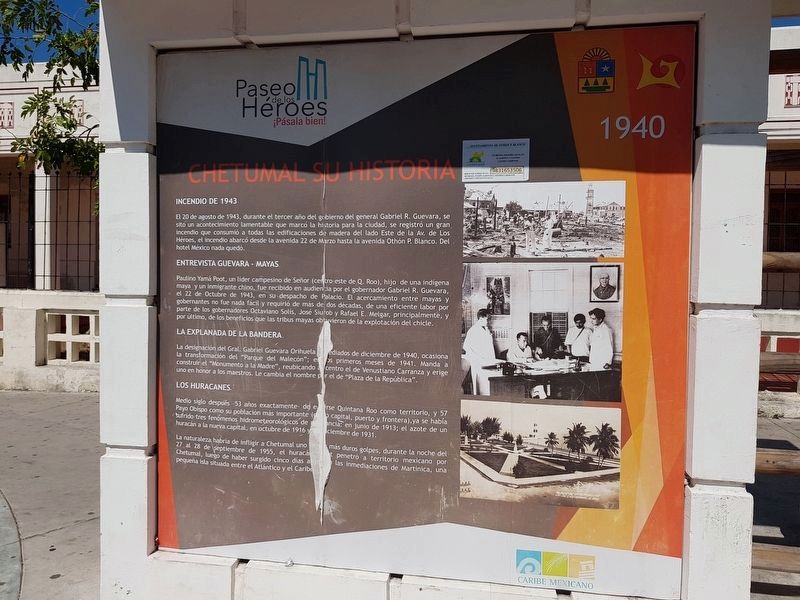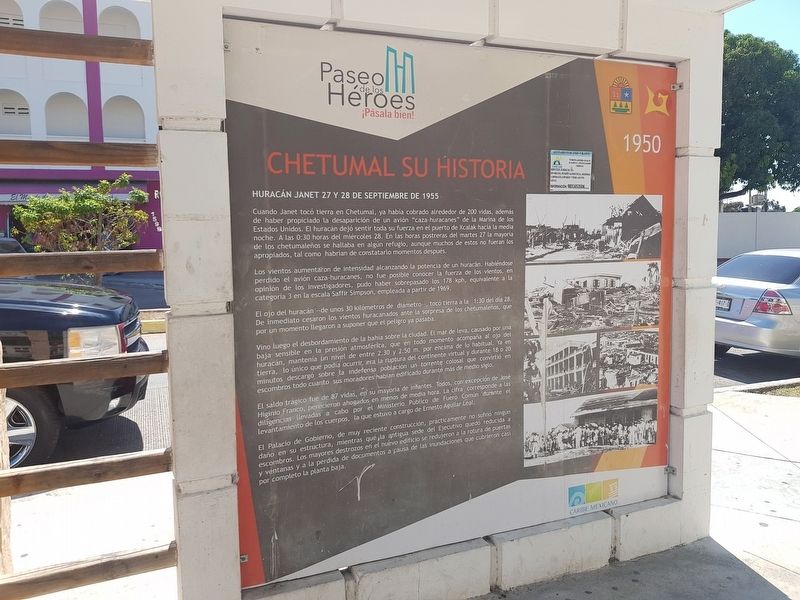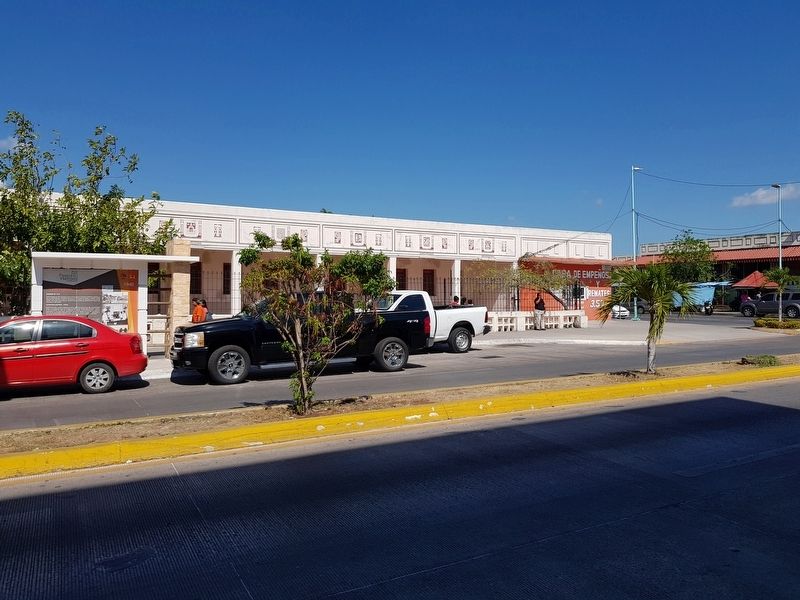Chetumal in Othón P. Blanco, Quintana Roo, Mexico — The Yucatan Peninsula (The Southeast)
The History of Chetumal: 1940-1950
Paseo de los Héroes
Inscription.
Incendio de 1943
El 20 de agosto de 1943, durante el tercer año del gobierno del general Gabriel R. Guevara, se sito un acontecimiento lamentable que marcó la hiştoria para la ciudad, se registró un gran incendio que consumió a todas las edificaciones de madera del lado Este de la Av. de Los Héroes, el incendio abarcó desde la avenida 22 de Marzo hasta la avenida Othón P. Blanco. Del hotel México nada quedó.
Entrevista Guevara-Mayas
Paulino Yamá Poot, un lider campesino de Señor (centro-este de Q. Roo), hijo de una indígena maya y un inmigrante chino, fue recibido en audiencia por el gobernador Gabriel R. Guevara, el 22 de Octubre de 1943, en su despacho de Palacio. El acercamiento entre mayas y gobernantes no fue nada fácil y requirió de más de dos décadas, de una eficiente labor por parte de los gobernadores Octaviano Solis, José Siurob y Rafael E. Melgar, principalmente, y por último, de los beneficios que las tribus mayas obtuvieron de la explotación del chicle.
La Explanada de la Bandera
La designación del Gral. Gabriel Guevara Orihuela a mediados de diciembre de 1940, ocasiona la transformación del "Parque del Malecón", en los primeros meses de 1941. Manda a construir el "Monumento a la Madre", reubicando al centro el de Venustiano Carranza y erige uno en honor a los maestros. Le cambia el nombre por el de “Plaza de la República”.
Los Huracanes
Medio siglo después -53 años exactamente- de elevarse Quintana Roo como territorio, y 57 Payo Obispo como su población más importante (como capital, puerto y frontera), ya se había sufrido tres fenómenos hidrometeorológicos de ..ancia: en junio de 1913; el azote de un huracán a la nueva capital, en octubre de 1916 y diciembre de 1931.
La naturaleza habría de infligir a Chetumal uno de los más duros golpges, durante la noche del 27 al 28 de Septiembre de 1955, el huracán Janet penetró a territorio mexicano por Chetumal, luego de haber surgido cinco días antes en las imediaciones de Martinica, una pequeña isla situada entre el Atlántico y el Caribe.
1950
Huracán Janet 27 y 28 de Septiembre 1955
Cuando Janet tocó tierra en Chetumal, ya había cobrado alrededor de 200 vidas, además de haber propiciado la desaparición de un avión "caza-huracanes" de la Marina de los Estados Unidos. El huracán dejó sentir toda su fuerza en el puerto de Xcalak hacia la media noche. A las 0:30 horas del miércoles 28. En las horas postreras del martes 27 la mayoría
de los chetumaleños se hallaba en algún refugio, aunque muchos de estos no fueran los apropiados, tal como habrían de constatarlo momentos después.
Los vientos aumentaron de intensidad alcanzando la potencia de un huracán. Habiéndose perdido el avión caza-huracanes, no fue posible conocer la fuerza de los vientos, en opinión de los investigadores, pudo haber sobrepasado los 178 kph, equivalente a la categoría 3 en la escala Saffir Simpson, empleada a partir de 1969.
El ojo de huracán – de unos 30 kilómetros de diámetro - , tocó tierra a la 1:30 del día 28. De inmediato cesaron los vientos huracanados ante la sorpresa de los chetumaleños, que por un momento llegaron a suponer que le peligro ya pasaba.
Vino luego el desbordamiento de la bahía sobre la ciudad. El mar de leva, causado por una baja sensible en la presión atmosférica, que en todo momento acompaña al ojo del huracán, mantenía un nivel de entre 2.30 y 2.50 m. por encima de lo habitual. Ya en tierra, lo único que podía ocurrir, era la ruptura del continente virtual y durante 18 o 20 minutos descargó sobre la indefensa población un torrente colosal que convirtió en escombros todo cuanto sus moradores habían edificado durante más de medio siglo.
El saldo trágico fue de 87 vidas, en su mayoría de infantes. Todos, con excepción de José Higinio Franco, perecieron ahogados en medios de media hora. La cifra corresponde a las diligencias llevadas a cabo por el Ministerio Público de Fuero Común durante el levantamiento de los cuerpos, la que estuvo a cargo de Ernesto Aguilar Leal.
El Palacio de Gobierno, de muy reciente construcción, prácticamente no sufrió ningún daño en su estructura, mientras qué la antigua sede del Ejecutivo quedó reducida a escombros. Los mayores destrozos en el nuevo edificio se redujeron a la rotura de puertas y ventanas y a la pérdida de documentos a causa de las inundaciones que cubrieron casi por completo la planta baja.
The Fire of 1943
On August 20, 1943, during the third year of the government of General Gabriel R. Guevara, an unfortunate event spelled disaster for the city when a great fire consumed all the wooden buildings on the east side of Avenida de Los Héroes. The fire spanned from Avenida 22 de Marzo to Avenida Othón P. Blanco. The Hotel Mexico was completely destroyed.
Guevara-Mayas Meetings
Paulino Yamá Poot, a peasant leader from the town of Señor (center-east of Quintana Roo), son of an indigenous Maya and a Chinese immigrant, was received in audience by Governor Gabriel R. Guevara on October 22, 1943, in his office in the Palacio. The meetings between Mayans and government leaders were not easy and required more than two decades of follow-up, an efficient work by the governors Octaviano Solis, José Siurob and Rafael E. Melgar, mainly, and finally, the benefits that the Mayas obtained from the exploitation of chewing gum.
The Esplanade of the Flag
With the designation of General Gabriel Guevara Orihuela in the middle of December 1940, the "Malecón Park" was transformed in the first months of 1941. He also ordered that the "Mothers’ Monument" be relocated to the center of Venustiano Carranza and also erected a monument in honor of teachers. The name of the plaza was changed to the "Plaza de la República" (Plaza of the Republic).
Hurricanes
Half a century later - 53 years exactly – since the designation of Quintana Roo as a territory, and 57 since the founding of Payo Obispo as its most important population (as capital, port and border), it had already suffered three serious hydrometeorological events: in June 1913, the scourge of a hurricane on the new capital in October 1916 and December 1931.
Nature would inflict on Chetumal one of the toughest blows during the night of September 27-28, 1955. Hurricane Janet penetrated Mexican territory in Chetumal, after having formed five days earlier near Martinique, a small island located between the Atlantic and the Caribbean.
1950
Hurricane Janet: September 27-28, 1955
When Janet made landfall in Chetumal, she had already claimed around 200 lives, in addition to having caused the disappearance of a “hurricane hunter” airplane of the United States Navy. The hurricane left its full force in the port of Xcalak towards midnight, at 0:30 hours on Wednesday 28. In the last hours of Tuesday 27 most of the Chetumalans were in shelters, although many of these were not appropriate, as they would soon see.
The winds increased in intensity, soon reaching the power of a hurricane. Having lost the hurricane-hunting plane, it was not possible to know the force of the winds. However, in the opinion of researchers, it could have exceeded 178 kph, equivalent to Category 3 on the Saffir-Simpson scale, used since 1969.
The hurricane eye - about 30 kilometers in diameter - touched land at 1:30 on the 28th. The hurricane winds immediately ceased, to the surprise of the Chetumalans, who for a moment believed that they were out of danger.
The overflow from the bay then came over the city. The sea wave, caused by a reduction in atmospheric pressure, which at all times accompanies the eye of the hurricane, maintained a level of between 2.30 and 2.50 m. above the usual. On land, for 18 or 20 minutes the hurricane unloaded on the defenseless population a colossal torrent that turned into rubble all that its inhabitants had built for more than half a century.
In total 87 lives were lost, mostly infants. All, with the exception of José Higinio Franco, were drowned in about a half-hour. The figure corresponds to the investigations carried out by the Public Prosecutor's Office during the removal of the bodies, which was in charge of Ernesto Aguilar Leal.
The Governmental Palace, recently constructed, practically did not suffer any damage, while the former Executive Headquarters was reduced to rubble. The greatest damage to the new building was the breaking of some doors and windows and the loss of documents due to the floods that almost completely covered the ground floor.
Topics. This historical marker is listed in these topic lists: Disasters • Man-Made Features • Wars, Non-US. A significant historical month for this entry is June 1913.
Location. 18° 30.128′ N, 88° 17.758′ W. Marker is in Chetumal, Quintana Roo, in Othón P. Blanco. Marker is on Avenida de los Héroes just north of Calle Héroes de Chapultepec, on the left when traveling north. Touch for map. Marker is in this post office area: Chetumal QR 77000, Mexico. Touch for directions.
Other nearby markers. At least 8 other markers are within walking distance of this marker. Hurricane Janet (a few steps from this marker); Avenida 5 de Mayo (within shouting distance of this marker); The History of Chetumal: 1960-1970 and 1970-1980 (within shouting distance of this marker); Juventino Rosas Theater (within shouting distance of this marker); Hospital Morelos (within shouting distance of this marker); Vice Admiral Othón Pompeyo Blanco Núñez de Cáceres (within shouting distance of this marker); Belisario Domínguez (within shouting distance of this marker); Dimas Sansores (within shouting distance of this marker). Touch for a list and map of all markers in Chetumal.
Credits. This page was last revised on May 15, 2019. It was originally submitted on March 30, 2019, by J. Makali Bruton of Accra, Ghana. This page has been viewed 237 times since then and 19 times this year. Photos: 1, 2, 3. submitted on March 30, 2019, by J. Makali Bruton of Accra, Ghana.


